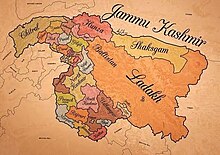Background
Previously Dogras had captured Yasin from Gaur Rehman in an invasion in 1860 and appointed Azmat Shah as the Governor of Yasin. But in 1863, Azmat Shah was deposed by his cousin brother, son of Gaur Rehman, Malik Aman. Azmat Shah fled to Jammu to ask help from Ranbir Singh.[3]
Battle
In 1866, Ranbir Singh again ordered Devi Singh to capture Yasin. Gen. Devi Singh, Col. Jawahar Singh and Col. Bijai Singh marched towards Yasin, where Malik Aman fled to Chitral and Azmat Shah was reinstalled as the governor of Yasin. [4]
Devi Singh further camped for some days outside Hunza until Mir Mirza Bahadur of Nagar joined hands with Jammu & Kashmir and the combined forces invaded Hunza. Mir Gazan Khan of Hunza and Aman ul Mulk of Chitral with Malik Aman charged upon dogra forces at Hunza Valley, where after a fierce battle Aman-Ul-Mulk retreated to Chitral. Gazan Khan was severely wounded and accepted the Suzerainty of Jammu & Kashmir.[1][3]
Aftermath
Yasin, Punial, Hunza and Nagar accepted the suzerainty of Jammu & Kashmir and started paying annual tribute, in return recieved annual subsidy.[5][6] Later in 1878, Chitral too signed a treaty and became a vassal state of Jammu & Kashmir.[7][8]
